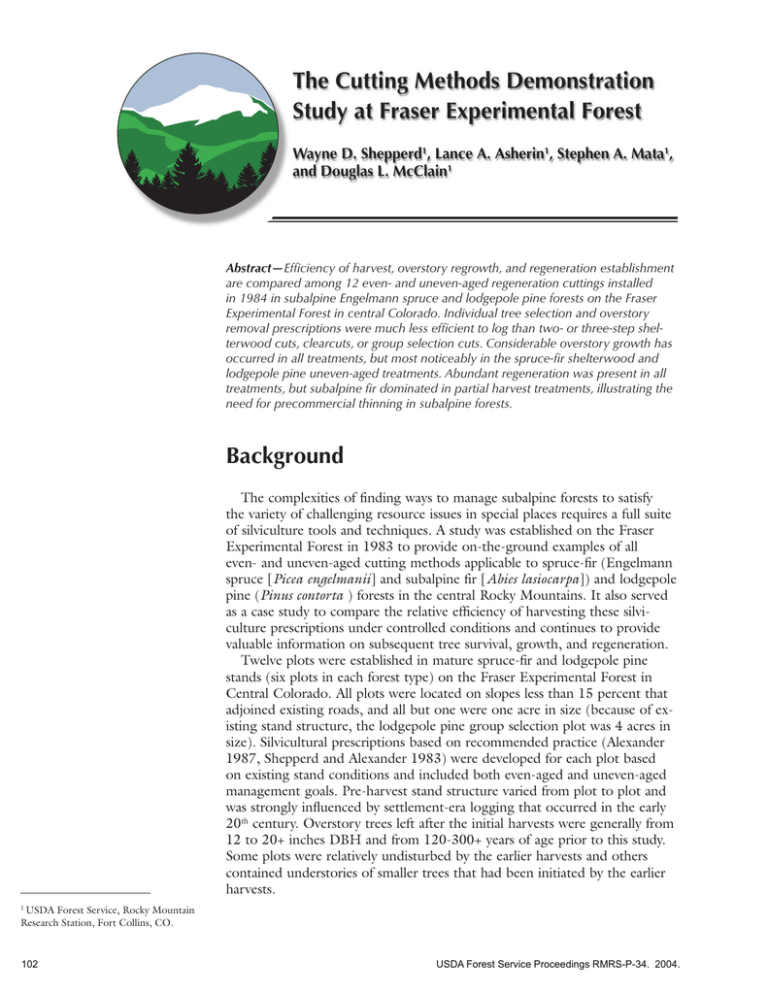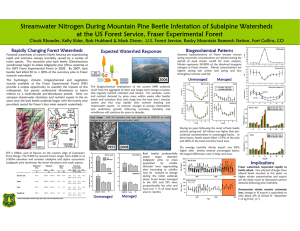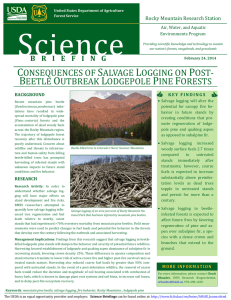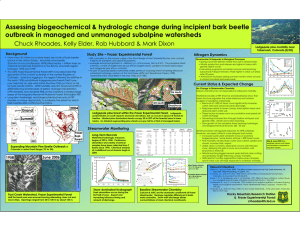The Cutting Methods Demonstration Study at Fraser Experimental Forest Wayne D. Shepperd
advertisement

The Cutting Methods Demonstration Study at Fraser Experimental Forest Wayne D. Shepperd1, Lance A. Asherin1, Stephen A. Mata1, and Douglas L. McClain1 Abstract—Efficiency of harvest, overstory regrowth, and regeneration establishment are compared among 12 even- and uneven-aged regeneration cuttings installed in 1984 in subalpine Engelmann spruce and lodgepole pine forests on the Fraser Experimental Forest in central Colorado. Individual tree selection and overstory removal prescriptions were much less efficient to log than two- or three-step shelterwood cuts, clearcuts, or group selection cuts. Considerable overstory growth has occurred in all treatments, but most noticeably in the spruce-fir shelterwood and lodgepole pine uneven-aged treatments. Abundant regeneration was present in all treatments, but subalpine fir dominated in partial harvest treatments, illustrating the need for precommercial thinning in subalpine forests. Background The complexities of finding ways to manage subalpine forests to satisfy the variety of challenging resource issues in special places requires a full suite of silviculture tools and techniques. A study was established on the Fraser Experimental Forest in 1983 to provide on-the-ground examples of all even- and uneven-aged cutting methods applicable to spruce-fir (Engelmann spruce [Picea engelmanii] and subalpine fir [Abies lasiocarpa]) and lodgepole pine (Pinus contorta ) forests in the central Rocky Mountains. It also served as a case study to compare the relative efficiency of harvesting these silviculture prescriptions under controlled conditions and continues to provide valuable information on subsequent tree survival, growth, and regeneration. Twelve plots were established in mature spruce-fir and lodgepole pine stands (six plots in each forest type) on the Fraser Experimental Forest in Central Colorado. All plots were located on slopes less than 15 percent that adjoined existing roads, and all but one were one acre in size (because of existing stand structure, the lodgepole pine group selection plot was 4 acres in size). Silvicultural prescriptions based on recommended practice (Alexander 1987, Shepperd and Alexander 1983) were developed for each plot based on existing stand conditions and included both even-aged and uneven-aged management goals. Pre-harvest stand structure varied from plot to plot and was strongly influenced by settlement-era logging that occurred in the early 20th century. Overstory trees left after the initial harvests were generally from 12 to 20+ inches DBH and from 120-300+ years of age prior to this study. Some plots were relatively undisturbed by the earlier harvests and others contained understories of smaller trees that had been initiated by the earlier harvests. 1 USDA Forest Service, Rocky Mountain Research Station, Fort Collins, CO. 102 USDA Forest Service Proceedings RMRS-P-34. 2004. Treatments Even-aged treatments were clearcutting (CC), the first entry of a two- and three-step shelterwood (SW2 and SW3), and overstory removal (OR). The latter treatment consisted of the removal of a mature overstory growing over a fully stocked sapling and pole-sized understory. Uneven-aged harvests were individual tree and group selection. Each treatment was duplicated in spruce-fir and lodgepole pine forest types. The BDQ method (Alexander and Edminster 1977) was used to regulate stocking in the uneven-aged prescriptions. A Q factor (the ratio of stem/acre in one DBH class to that of the next smaller class) of 1.3 (using 1-inch DBH classes) was used in spruce-fir with DBH classes ranging from 4 to 24 inches, the maximum retained diameter. Residual basal area targets after cutting were 80 ft2/acre in the uneven-aged treatments. The same Q factor BDQ prescription was chosen for the unevenaged lodgepole pine treatments, except the upper DBH limit was 18 inches. These uneven-aged configurations were selected because they (1) closely matched the distribution of growing stock on the sites, (2) removed sufficient growing stock to expect new regeneration, and (3) allowed the residual forest to remain at low risk to windthrow. All areas were logged during one season by the same contract logger using chainsaw felling and bucking and a rubber tired cable skidder to remove and deck logs. The logger was free to log the plots as he saw fit but had to remove all marked stems, use designated skid trails, and not damage residual stems. Researchers observed all logging and kept detailed notes on the amount of time spent in felling, skidding, decking, and cleanup of each harvest unit. Every log was scaled and the number of pieces removed in each skidder turn was recorded. Logging efficiencies for each one-acre harvest treatment unit were estimated by calculating the cubic feet of wood removed divided by the total hours of effort required by all members of the logging crew to complete the unit, resulting in a person-hour/ft3 production rate. Data for the four-acre lodgepole pine group selection unit were adjusted to a per-acre basis. Results Post-Harvest Specific pre- and post-treatment stocking data are listed in table 1. The seed cuts removed 60 percent and 65 percent of the pretreatment growing stock from the spruce-fir and lodgepole two-step shelterwood plots, respectively. The preparatory three-step shelterwood cuts removed 40 percent and 30 percent of the stocking from the spruce-fir and lodgepole pine plots, respectively. All of the growing stock above 3.5 inches DBH was removed from the overstory removal and clearcut treatments. The individual tree and group selection treatments removed 28 to 55 percent of the pretreatment growing stock distributed as closely as possible to the target diameter class stocking curves. All visible pre-existing seedlings and saplings were removed from shelterwood and clearcut treatments to facilitate observation of the regeneration response to these treatments. Some windthrow occurred in both the spruce and lodgepole shelterwood treatments, as might be expected (Alexander 1987, Shepperd and Alexander 1983). USDA Forest Service Proceedings RMRS-P-34. 2004. 103 Table 1—Conditions existing pre- and post-treatment and in 2003 by forest type and harvest treatment: overstory basal area per acre (BA); trees per acre (TPA); and quadratic average stand diameter (DQ). Treatment codes: SW3 = three-step shelterwood. SW2 = two-step shelterwood. ITS = individual tree selection. CC = clearcut. OR = overstory removal. GS = group selection. Engelmann Spruce – Subalpine Fir Treatment Pre BA Pre TPA Pre DQ BA cut % BA cut TPA cut Post BA Post TPA Post DQ 2003 BA 2003 TPA 2003 DQ BA change SW3 SW2 ITS CC OR GS 205 220 176 136 160 165 229 160 285 200 341 223 12.8 15.8 10.6 11.2 9.3 11.6 82 132 97 136 160 69 40 60 55 100 100 31 85 185 229 241 426 53 102 88 * 79 0 +0 95.7 78 65 199 0 0 155 15.4 11.8 8.5 0 0 10.6 77.1 97.6 136.2 0 40.4 124.6 46 57 347 0 268 199 17.5 17.7 8.5 0 5.3 7.7 ® -24.1 ® 9.6 Post TPA Post DQ 2003 BA 2003 TPA 2003 DQ BA change 147 100 252 0 0 281 11.7 11.8 7.6 0 0 6.7 94.6 68.8 136.2 0 4.4 108.4 112 74 432 0 32 364 12.4 13.0 7.2 0 5.0 7.3 ® -16.0 ® -1.3 57.2 0 40.4 28.9 Lodgepole Pine Treatment Pre BA Pre TPA Pre DQ BA cut % BA cut TPA cut SW3 SW2 ITS CC OR GS 156 220 145 180 98 100 232 285 481 241 426 334 11.1 11.9 7.4 11.7 7.1 7.4 47 143 65 180 97 28 30 65 45 100 100 28 151 95 86 200 341 68 Post BA 110.6 75.3 79.0 0 0 67.5 57.2 0 4.4 40.9 * Marked to 80 BA, 5 stems lost due to logging. + Understory not included. ® Reduced due to windthrow losses. Efficiency of Harvest Logging activities are presented on a person-hour and cubic volume basis in table 2. Harvest efficiency expressed in terms of person-hours/ft3 is compared by prescription and species in figure 1. Production rates did not vary substantially, except that individual tree selection and overstory removal prescriptions were much less efficient to log, due to the necessity of avoiding existing seedlings and saplings in these treatments. Pieces of all sizes were removed from all plots (table 2), reflecting the irregular structure of the preexisting forest. However, the larger piece sizes in group selection treatments was a consequence of harvesting predominately mature groups of trees in those stands. Conditions in 2003 Nineteen years after the 1984 harvests, all of the 12 treatment plots are fully stocked and remain in healthy condition. Considerable overstory basal area growth has occurred in group and individual-tree selection treatments, but windthrow losses have affected growth in shelterwood treatments (table 1). However, Scribner volumes (board feet/acre) increased most noticeably in the spruce-fir shelterwood (figure 2) and in lodgepole pine uneven-aged treatments (figure 3). Scribner volumes in the latter treatments have nearly grown back to pre-harvest levels (figure 3). Current diameter distributions of all uneven-aged treatments (figures 4, 5) show stocking surpluses are greatest in the smaller diameter classes. Sufficient surpluses exist in larger diameter classes in both spruce-fir and lodgepole individual tree selection treatments (figure 5) to currently support another commercial entry cycle (figure 3). All treatment plots are currently stocked with regeneration well in excess of regional guidelines (USDA Forest Service, Rocky Mountain Region 104 USDA Forest Service Proceedings RMRS-P-34. 2004. Table 2—Comparison of harvest activities by silviculture treatment. Engelmann Spruce Treatment SW3 SW2 ITS CC OR GS Felling and bucking ---------------------Skidding -------------------ft3/ No. Logs/ ft3/ ft3/ Hours hour Hours turns turn piece hour 51.2 37.1 45.4 22.3 79.7 21.2 178.9 148.2 91.5 311.4 57.3 290.3 34.0 21.6 84.7 14.6 59.1 20.2 86.1 56.1 52.1 56.1 91.1 44.0 4.3 4.4 4.0 4.4 3.9 3.8 25.0 22.2 19.9 28.4 12.7 37.0 Cleanup Total hours Other * hours ft3/ hour Total ft3 269.8 24.5 0.0 109.7 254.5 12.8 0.5 72.0 49.1 27.0 0.0 157.1 474.9 37.5 0.0 74.4 77.3 9.5 0.0 148.3 304.4 22.8 0.8 64.9 Engelmann spruce averages 83.5 76.4 26.4 93.3 30.8 94.6 58.2 9161.0 5498.0 4154.0 6939.0 4570.0 6142.0 36464.0 Total hours ft3/ hour Total ft3 154.5 4.0 0.6 62.8 194.2 5.0 0.9 49.7 177.0 17.0 0.0 56.2 272.3 6.8 0.0 70.7 37.6 6.0 0.0 96.7 206.0 12.0 1.1 66.5 Lodgepole pine averages 80.5 93.7 43.6 110.6 22.7 88.7 69.7 5056.0 4657.0 2448.0 7817.0 2197.0 5897.0 28072.0 Lodgepole Pine Treatment SW2 SW3 ITS CC OR GS Felling and bucking ---------------------Skidding------------------ft3/ No. Logs/ ft3/ ft3/ Hours hour Hours turns turn piece hour 25.5 19.8 25.3 36.0 32.2 24.8 198.3 235.1 96.6 217.1 68.3 238.3 32.7 24.0 13.8 28.7 58.5 28.6 74.0 56.0 31.0 73.1 32.0 49.1 5.0 4.8 4.6 4.8 5.1 4.9 13.7 17.2 17.4 22.3 13.5 24.4 Cleanup hours Other * * Includes repair, skid trail construction, etc. 120 Spruce-fir Lodgepole pine 100 Figure 1—Harvest production rates in cubic feet per person-hour by forest type for clearcut (CC), three-step shelterwood (SW3), group selection (GS), two-step shelterwood (SW2), individual tree selection (ITS), and overstory removal (OR) cutting methods. 3 ft /hr 80 60 40 20 0 CC SW3 GS SW2 ITS OR Reforestation Handbook) for spruce-fir and lodgepole pine forests (table 3). The abundance of small seedlings indicates that new trees are still being recruited into these areas. The predominance of subalpine fir in all spruce-fir treatments is also noteworthy. Fir will obviously dominate the future stocking in all of the spruce-fir treatment plots, but especially so in the individual tree selection and three-step shelterwood treatments. USDA Forest Service Proceedings RMRS-P-34. 2004. 105 Spruce-fir Scribner fbm/ac 30000 25000 20000 1983 1984 2003 15000 10000 5000 0 SW3 SW2 ITS CC OR GS Figure 2—Pre-harvest, post-harvest, and 2003 board foot Scribner volumes in spruce-fir units by silviculture treatment. Lodgepole pine Scribner fbm/ac 30000 25000 20000 1983 1984 2003 15000 10000 5000 0 SW3 SW2 ITS CC OR GS Figure 3—Pre-harvest, post-harvest, and 2003 board foot Scribner volumes in lodgepole pine units by silviculture treatment. Discussion These demonstration areas on the Fraser Experimental Forest provide an opportunity to view and compare a variety of management options in one readily accessible location. All of these treatments have been successful in that they resulted in the establishment of new regeneration, successfully prepared the forest for subsequent entries without excessive windthrow, or have demonstrated the applicability of both even-aged and especially uneven-aged regeneration methods in both spruce-fir and lodgepole pine forest types. The production data collected during the 1984 harvests clearly show that conventional handfelling and tractor skidding was possible in all treatments. Although the overstory removals in the overstory removal treatments were least efficient, performing these operations while regeneration was still in the seedling stage would lessen damage from equipment and tree falling and substantially increase harvest efficiency. Using new mechanical harvesting equipment available since this study was harvested would probably increase 106 USDA Forest Service Proceedings RMRS-P-34. 2004. Trees / acre Engelmann spruce group selection 100 90 80 70 60 50 40 30 20 10 0 2003 Q 1.2, BA=85 Figure 4—Comparison of 2003 stocking by diameter class with target stocking guidelines for spruce-fir and lodgepole pine group selection treatments. The LP03 and ES-SF03 labels indicate 2003 stocking of lodgepole pine, spruce, and fir in the lodgepole group selection treatment. 4 5 6 7 8 9 10 11 12 13 14 15 16 17 18 19 20 21 22 23 24 25 26 27 28 DBH Lodgepole pine group selection 100 90 LP03 ES-SF03 Q 1.3, BA=80 80 Trees / acre 70 60 50 40 30 20 10 0 4 5 6 7 8 9 10 11 12 13 14 15 16 17 18 19 20 21 22 23 24 25 26 27 28 DBH the harvest efficiency in all treatments, but the ranking of treatments would likely not change, since it was closely related to the number of pieces that needed to be moved. Both the appearance and the current stocking of these plots indicate that additional silviculture activities are needed in all of these treatments. Sufficient growth and regeneration have occurred in the two-step shelterwood plots that overstory removals could now be done. Adequate wind firmness and advanced regeneration exist in the three-step shelterwood treatments so that seed cuts could now be completed. Stocking has increased in the uneven-aged treatments to the point that growing stock should once again be reduced to desired levels by another cutting cycle harvest. A more critical concern with regard to the future composition of these forests would be the need to precommercially thin excessive subalpine fir stocking from both the spruce-fir and lodgepole pine plots. Subalpine fir comprises the majority of seedling and sapling stocking in the spruce-fir individual tree selection, group selection, overstory removal, and three-step shelterwood treatments. Subalpine fir also accounts for over 30 percent of the regeneration in the lodgepole pine individual tree selection and overUSDA Forest Service Proceedings RMRS-P-34. 2004. 107 Trees / acre Engelmann spruce individual tree selection 100 90 80 70 60 50 40 30 20 10 0 2003 4 6 8 10 12 14 16 18 20 22 Q 1.3 BA=80 24 26 28 DBH Trees / acre Lodgepole pine individual tree selection 100 90 80 70 60 50 40 30 20 10 0 LP03 4 6 8 10 12 14 16 ES-SF03 18 20 Q 1.3, BA=80 22 24 26 28 DBH Figure 5—Comparison of 2003 stocking by diameter class with target stocking guidelines for spruce-fir and lodgepole pine individual tree selection treatments. The LP03 and ES-SF03 labels indicate 2003 stocking of lodgepole pine, spruce, and fir in the lodgepole individualtree selection treatment. story removal treatments. Subalpine fir is much more shade tolerant than either spruce or lodgepole pine and can persist very well under these other species. As the fir trees grow larger, the dense shade cast by their full crowns will strongly inhibit the ability of lodgepole pine and spruce to successfully establish. The result will be a type-shift to fir dominated forests rather than the spruce and lodgepole forests that we intended to regenerate. In many ways these demonstration plots represent conditions and trends that are present in many special places throughout the central and southern Rocky Mountains. This study clearly illustrates that forest conditions are not static but dynamically change over time in response to disturbance. If that disturbance is a program of silviculture treatments intended to improve the condition of the forest, we are obligated to continue management to either ultimately replace the forest or maintain it in a desired condition. The natural advantage that shade-tolerant subalpine fir has in establishing under overstory canopies ensures that management goals for any partial cutting silviculture treatment in subalpine forest types cannot be accomplished unless precommercial thinning is an integral part of the silvicultural system. 108 USDA Forest Service Proceedings RMRS-P-34. 2004. Table 3—Number of seedlings and saplings (<3.5 inches DBH) per acre in 2003 by harvest treatment, species, and size class. Engelmann Spruce Tree species Treatment OR CC SW2 SW3 ITS GS1 Average Engelmann Lodgepole Subalpine spruce pine fir 780 720 1230 330 2053 429 924 180 240 150 0 0 0 95 2010 480 720 930 3130 2210 1580 OR CC SW2 SW3 ITS GS1 Average 1 Engelmann Lodgepole Subalpine spruce pine fir 80 30 150 150 307 334 175 550 2520 3300 3660 1538 2733 2384 Total Less than 1.5 ft. 1.5 to 4.5 ft ht. 2970 1440 2100 1260 5183 2639 2599 750 540 990 480 1440 510 785 990 240 540 360 2340 900 895 Lodgepole Pine Tree species Treatment Size class 550 120 630 840 1061 429 605 4.5 ft. to 1 to 3.5 in. Percent 1 in. DBH DBH stocking 750 360 450 300 900 720 580 480 300 120 120 503 509 339 100 80 100 80 100 90 92 Size class Total Less than 1.5 ft. 1.5 to 4.5 ft ht. 1180 2670 4080 4650 2906 3496 3164 250 180 2370 3090 1650 1350 1482 150 420 900 1050 570 870 660 4.5 ft. to 1 to 3.5 in. Percent 1 in. DBH DBH stocking 280 780 570 390 240 510 462 500 1290 240 120 446 766 560 100 80 100 90 100 95 94 Group selection (GS) treatments include regeneration in group openings and intervening forest. Literature Cited Alexander, Robert R. 1987. Ecology, silviculture, and management of the Engelmann spruce-subalpine fir type in the central and southern Rocky Mountains. Agric. Handb. 659. Washington, D.C.: U.S. Department of Agriculture, Forest Service. 144 p. Alexander, Robert R.; Edminster, Carleton B. 1977. Regulation and control of cut under uneven-aged management. Res. Pap. RM-182. Fort Collins, CO: U.S. Department of Agriculture, Forest Service, Rocky Mountain Forest and Range Experiment Station. 7 p. Shepperd, Wayne D.; Alexander, Robert R. 1983. Silviculture of lodgepole pine in the central Rocky Mountains. Publication RMTT-3. Fort Collins, CO: U.S. Department of Agriculture, Forest Service, Rocky Mountain Forest and Range Experiment Station. 36 p. USDA Forest Service Proceedings RMRS-P-34. 2004. 109






